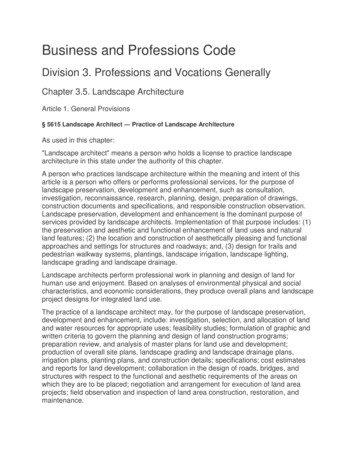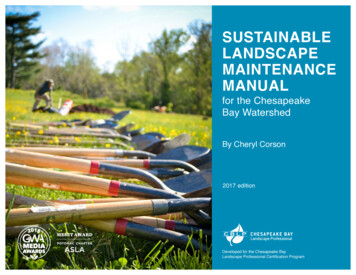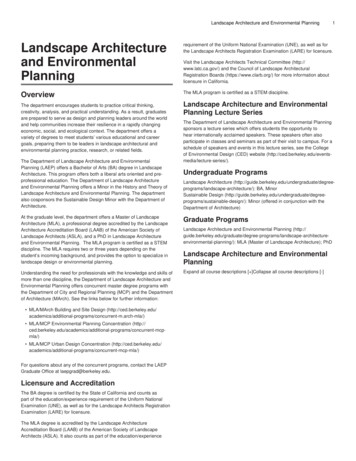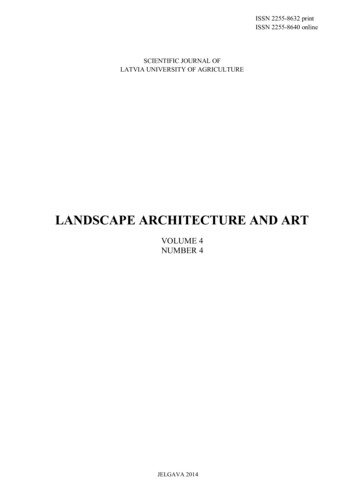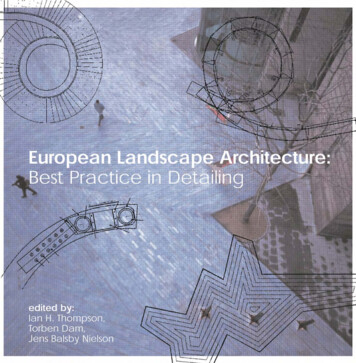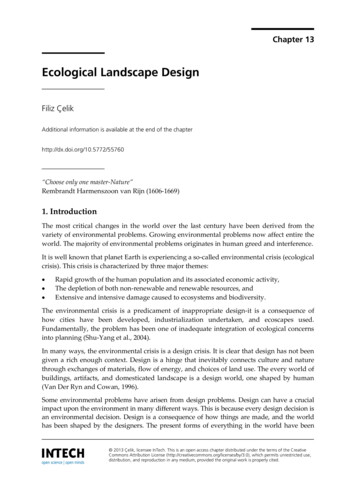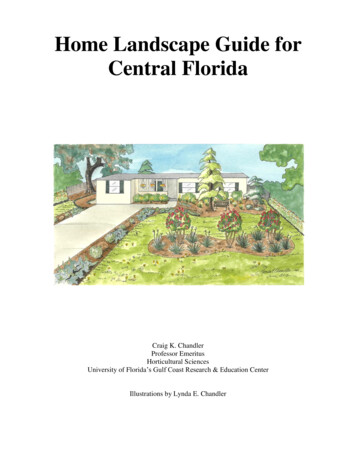
Transcription
Home Landscape Guide forCentral FloridaCraig K. ChandlerProfessor EmeritusHorticultural SciencesUniversity of Florida’s Gulf Coast Research & Education CenterIllustrations by Lynda E. Chandler
First printing 2013
Table of ContentsPreface .1Central Florida’s natural environment . .1Landscape design .3Plant materialTrees .6Shrubs .9Herbaceous perennials .9Ground covers .10Turfgrass .10Annuals .10Citrus .12Other fruits .13Vegetables and herbs .13Plant maintenanceWatering .16Fertilization .17Pruning .18Mulching 26Disease and pest control 27Freeze protection .29AppendixEssential gardening tools .30Reliable sources of information 31
PrefaceThis booklet is intended primarily for first time homeowners or forhomeowners who would like to make their home landscape more functional andeco-friendly. I realize that many homeowners now rely on landscape servicecompanies to plant and maintain their turfgrass and other outdoor plants.However, it is still useful for homeowners to have some basic knowledge oflandscape design and maintenance. The landscape service industry is largely anun-regulated industry. Some industry workers have extensive training, whileothers have little or none. So even if you don’t plant or maintain your ownlandscape, being a knowledgeable consumer can help you make sure that thelandscape operator doesn’t perform unnecessary or ineffective services.This publication is not comprehensive, but it cites websites that include plantphotos and detailed research-based information on numerous landscape andgardening topics.Central Florida’s Natural EnvironmentClimate and weatherCentral Florida has a sub-tropicalclimate, with a distinct rainy season anddry season. The rainy season typicallystarts in mid June and ends in midSeptember, while the dry season runsfrom October through May. Novemberand April are historically the two driestmonths of the year in central Florida.(The old saying “April showers bringMay flowers” doesn’t apply to this area!)Air temperatures during sunny summerdays will consistently rise to the mid 90sinland, with air along the coast slightlycooler. Thunderstorms can lower airtemperatures into the 80s or even high70s – at least temporarily. Daily hightemperatures during the winter are oftenin the 70s, with daily lows in the 50s.However, occasionally a strong coldfront will move down the peninsula fromthe north or northwest and lowernighttime air temperature to 32 degreesor below.The duration of these freezes is usuallyquite short, often lasting a few hours orless. But, if the air mass over the regionis very dry and the wind dies down andthe sky is clear (cloudless), airtemperature will drop quickly aftersunset, and freezing conditions can lastfrom 9 or 10 in the evening until aftersunrise the next morning.Just as coastal areas tend to be slightlycooler than inland areas during summerdays, they tend to be slightly warmerthan inland areas during winter nights.The Gulf of Mexico and Atlantic Oceanhave a moderating effect on airtemperature. This same moderating1
effect can occur on property that is onthe downwind side of lakes. This is whytropical plants have a higher survivalrate when grown close to these bodies ofwater.Central Florida is in USDA planthardiness zones 9a and 9b, which havean average minimum temperature rangeof 20-25 and 25-30 F, respectively.Land close to the coast will be in zone9b, while inland areas of central Floridaare generally in zone .Many of us try to create a tropical lookin our yards. We plant thryallis, cassia,allamanda, and philodendrons (native totropical America); pygmy date palms,crotons, hibiscus, and ixora (native totropical Asia); plumbago and pentas(native to tropical Africa); arboricolasand bottle brush (native to tropicalAustralia); and shell ginger (native to thesouth sea islands).injury (which can include slow growth,lesions on the leaves, and wilting), andthis injury can occur at temperaturesabove 32 F.Chill-sensitive plants tend to have a highpercentage of saturated fat in their cellmembranes, which solidifies at arelatively high temperature, resulting ina loss of membrane function andsubsequent damage. Depending on theamount of saturated fat in theirmembranes some species may bedamaged when temperatures fall to themid to upper 30s, while the most chillsensitive plants, such as some orchids,may be damaged when exposed totemperatures in the 40s and 50s.When air temperatures drop below 32,injury to plants is caused primarily bythe formation of ice crystals within cells.Aqueous solutions expand as they freezeand this expansion ruptures the cells.Freeze-resistant species havemechanisms to limit the formation of icecrystals. For example, antifreezeUnfortunately, species that are native toproteins have been identified that bind totropical areas (especially the lowlands)ice crystals and prevent or slow furtherare generally susceptible to --------------------------SoilMost of the top soil on home sites inCentral Florida consists of sand, and hasvery little silt, clay, or organic matter.Therefore, it has low water and nutrientholding capacity.Typically, the soil around a house inCentral Florida is well drained – unlessthe site was improperly graded. Thiscould include the removal of top soilprior to construction of the house andfailure to replace it after construction is2completed. Also, heavy equipment, usedduring construction, can compact soil toa degree that reduces the ability of waterto move through the soil quickly.For a more detailed discussion of thissubject, see Preplant Soil Assessment forNew Residential Landscapes in Florida(http://edis.ifas.ufl.edu/ss534).
Landscape designGenerally, the types and placement of plants in the home landscape can be determined bythe function you want them to serve. Here are some possible functions: focus attention on your home’s most outstanding attribute (which in most cases isthe front entrance) shade the west, east and south windows from direct sunlight slow cold winter winds (which generally come from the north and northwest) create outdoor living and recreation areas block unsightly views provide habitat for wildlife provide fresh herbs, vegetables, fruits, and flowers for home ----------A plant can serve more than onethat are cold hardy, drought tolerant, andfunction. And in fact, on smallrequire little, if any, pruning. In centralresidential lots plants often serveFlorida, this includes trees such asmultiple functions. For example, in mywinged elm, bald cypress, and crapehome landscape, I planted a lemon treemyrtle; shrubs such as yaupon holly,to provide my family and friends withwalter’s viburnum, and florida zamia;fresh lemons. But this tree also shades aand ground covers such as asian jasminewest facing window from the afternoonand sunshine mimosa.sun and provides perches for small birds.Include only as much lawn in yourIf you don’t enjoy yard work and want todesign as you need for recreation –keep landscape establishment andbecause turfgrass requires more regularmaintenance costs to a minimum, strivemaintenance than just about any otherfor a simple design and choose plantstype of plant.Lawns continue to be the norm in America, despite the fact that large regions of thecountry (including Florida) have climates that are too hot, cold, or dry for turf grassesto grow naturally. Science and technology, in the form of new varieties, powermowers, string trimmers, irrigation systems, and synthetic fertilizer, weed killers, andpesticides, have made it possible for homeowners from Florida to California to growturfgrass. Billions of dollars are spent annually on this landscape aesthetic, and yetmany lawns fall short of what is considered ideal: a single type of grass, withoutbrown patches, bare spots, or intruding weeds, kept neatly edged and mown to auniform height.Is a lawn – an area of seldom used space – really worth all the time, energy, andmoney we devote to it? In the last few decades there has been movement towardlower input landscapes. These include shade gardens and beds of low growing shrubsand herbaceous perennials separated by paths made with stepping stones or mulch.Ecologically, these alternative landscapes make more sense than a monoculture ofnon-native turf. And although beauty is in the eyes of the beholder, many now thinkthey are more beautiful and interesting, as well.3
Instead of scattering shrubs and treesthroughout open areas, group them inmulched beds. This will make mowingeasier and faster.If you only have funds for a limitednumber of plants you’re likely to get themost bang for the buck with a fewmedium to fast growing shade trees.They can greatly reduce the heat load onyour house – if planted in the properlocation (see below) – and eventuallywill give you the opportunity to plantsome interesting understory (shadeloving) plants.By planting a tree, you can also help reduce the amount of carbon dioxide (CO2) inthe atmosphere. (CO2 is a gas that has been linked to global warming.) Growingtrees absorb CO2 from the air and use the carbon to make wood. Trees sequesterabout 1.5 pounds of CO2 for every 1 pound of new wood they produce.Large evergreen shrubs, such asviburnum and podocarpus, can be usedto block unsightly views, create privacyfor outdoor living areas, and serve aswindbreaks, but fencing can alsoaccomplish these functions (often morequickly and with less regularmaintenance).A common mistake is to plant too manyshrubs and trees. Give them room toreach their mature size, realizing that forplants purchased in small containers thiscan take three to five years for shrubsand 10 years or more for trees.Years ago my family and I moved into a new house. There were a few mediumsized oak trees in the front yard and a couple of small sabal palms in the side yard,but other than these native plants, our lot was pretty much a blank slate. My wifeand I both have degrees in horticulture, so you’d think we’d know what to plant andwhere. But despite our training we’ve made plenty of mistakes over the years. Onesuch mistake was planting a japanese privet (Ligustrum japonicum) a few feet infront of our house. We bought a three-gallon size privet, and our plan was to trainthis plant into a multi-stemmed specimen shrub. The plan worked until a few yearsago, when we realized we could no longer keep this plant a reasonable size withoutdistorting its shape and rendering it unattractive. Finally, I did the deed: I spentalmost an entire day, sweating and grunting, getting rid of this plant, roots and all.The small, inexpensive privet, which we had purchased over a decade prior, hadgrown into a house-eating monster with a trunk circumference of two feet!Unfortunately this scenario is all too common. I see overgrown shrubs covering uphouses and partially blocking driveways and sidewalks all over my neighborhood.The most common culprits (in addition to ligustrum) are podocarpus (Podocarpusmacrophylla), sweet viburnum (Viburnum odoratissimum), and Arbor-Vitae (Thujaorientalis).So before you purchase a cute little plant and put it in your yard, consider its mature sizeand the work or expense that is involved in its removal.4
A great way to add splashes of color tosoils and therefore are more efficientyour landscape without using a lot ofmediums in which to grow droughtwater is to grow annuals and herbaceoussensitive plants. Usually just one to twoperennials in large sturdy pots filled withgallons of water per pot will keepa commercial potting mix. Pottingpotting mixes moist for several days – ormixes, which are composed mostly ofeven longer if the pot is in a shadyorganic matter, have a higher waterlocation.holding capacity than our native ------------Proper placement of shade trees in the home landscapeA.W. Meerow and R.J. Black havewritten an excellent article(http://edis.ifas.ufl.edu/EH141) titledEnviroscaping to Conserve Energy:Trees for Central Florida. Here are someof the highlights of the article: House walls are the most practical surface to shadebecause new tree plantings take many years to cast aneffective shadow on the roof. In general, the target areas for shading are the walls facingwest, east, and south –in that order. Though a south facingwall receives little direct sun on June 21st, by August thesun is low enough in the sky to increase considerably theheat load on this wall. Windows provide the most directentry for heat into a house. Consequently, specialattention may need to be given to walls containing themost windows. To provide effective shade within 5 years, plant the tree 7to 20 feet from the wall. (The distance you choose shoulddepend on the expected mature height and breadth of thetree.) Deciduous trees (i.e. trees that lose their leaves in the fall)are recommended for planting on the south, southeast, andsouthwest sides of the house. Their bare winter canopiesallow the sun to warm the house during the day.Evergreen trees (i.e. trees that retain their leaves yearround) are recommended for planting at the northwestcorner of the house. This type of tree, in addition to theshade it provides, can be a barrier to cold winter winds.For more information on landscape design, see Florida-FriendlyLandscaping at http://www.floridayards.org/.5
Plant materialTreesMature shade trees are giant airconditioners. They not only helpremove dust and other pollutants fromthe air, they cool the air (by dissipatingheat from the surfaces of their leaves) ina process called transpiration.Evaporative cooling takes place as aresult of transpiration – as it also doeswhen we perspire. So, by steppingunder a big oak, you’re, in a manner ofspeaking, letting the tree do some of thesweating for you!shade trees. They are on land that wasformerly planted in pasture or citrus.Hopefully the developers of theseneighborhoods have established treesthat will someday provide homeownersand their kids, who are out mowing thelawn or playing ball, a pleasant respiteon a sunny summer day. If they haven’tand you live in one of theseneighborhoods, or your yard, forwhatever reason, is without shade, hereis some information to help you decidewhich species of shade tree might beright for your site:Unfortunately, many new neighborhoodsin central Florida don’t have any -------------6 Bald cypress. Height*: 60-80ft.; spread: 25-35 ft.; growth rate:fast. Resistant to high winddamage. Leaves turn a coppercolor in the fall. Callery pear. Height: 30-40 ft.;spread: 30-40 ft.; growth rate:fast. This relatively shorted livedornamental tree is native toChina. The best known cultivarof the species is ‘Bradford’. Thefall color of callery pears, insome locations and in someyears, can be spectacular,running the gamut from yellowto dark maroon. Chinese elm. Height: 40-50 ft.;spread: 35-50 ft; growth rate:medium; Leaves turn yellow inthe fall. Crape myrtle. Height: 25-50 ft.(depending on variety); spread:25-35 ft; growth rate: fast. Thisis one of our most popularlandscape plants – probablybecause it has so much to offer:showy flowers, attractive bark,and fall color that starts offyellow before turning to abeautiful orange-red. Green ash. Height: 50-100 ft.;spread: 30-70 ft.; growth rate:fast. The leaves of this tree turnyellow in the fall, although, incentral Florida, the color ismuted in most years. Femaletrees of this species produce seedthat are food for many types ofbirds. Live oak. Height: 40-80 ft;spread: 60-120 ft.; growth rate:medium. Resistant to high winddamage. This tree is essentiallyevergreen. It sheds its old leaves
gum: its hard spiny fruit, whenon the ground, can be tough onbare feet.shortly before new leaves emergein the spring. Red maple. Height: 35-80 ft.;spread: 25-35 ft.; growth rate:fast. The most outstandingfeature of this native species is itsfall color, which can be yellow,orange, and red – sometimes allon the same tree. It does bestwhen growing in moist soils.Shumard oak. Height: 55-80ft.; spread: 40-50 ft.; growth rate:fast. Medium to high resistanceto wind damage. Leaves turnshades of red and orange in thefall. Southern magnolia. Height: 4080 ft.; spread: 15-40 ft. (size andshape vary among varieties);growth rate: medium. This is adurable, evergreen tree that holdsup well to both high wind andcoastal conditions. Sweet-gum. Height: 40-100 ft.;spread: 40-60 ft.; growth rate:medium. Medium to highresistance to wind damage. Thisnative tree can produce somebrilliant (orange and red) fallcolor. One down side of sweet- Turkey oak. Height: 30-50 ft.;spread: 30-50 ft.; growth rate:medium. This deciduous oak hasturkey-foot-shaped leaves thatturn shades of yellow, orange,and red in the fall. Winged elm. Height: 45-70 ft.;spread: 30-40 ft.; growth rate:fast. Medium to high resistanceto wind damage. Leaves turnyellow in the fall. Yaupon holly (tree type).Height: 15-30 ft.; spread: 6-12ft.; growth rate: medium. Thisnative small tree is evergreen, butcan produce an impressivedisplay of bright red berries inthe fall. Purchase a plant withberries on it (i.e. a female) if youwant a berry-producing tree.*Height and spread measurements arefor mature trees.For more details on these and otherdesirable trees, see the plant database athttp://floridayards.org/fyplants/index.php.7
Trees to avoidin hundreds of seedlings comingup in the vicinity of the tree.Cherry laurel is native to Florida,but is generally notrecommended for residentiallandscapes.Inherently, no tree is bad. Everyplant has its place – but there areseveral that are not appropriatefor small residential front yards. Camphor. Camphor can be anice evergreen shade tree – in alarge backyard or a park – butit’s not suited for a smallresidential lot. It producesprolific numbers of black, peasize fruit, which are good atstaining cars, driveways, andsidewalks. Also, it’s not easy togrow other plants beneath acamphor tree because of thedense shade it produces and theherbicidal effects of its leaf litter.Despite being a non-native andsomewhat invasive, camphortrees are still generally protectedby local municipalities, althoughin Pasco County camphor treescan be removed without a permitand in the city of Temple Terraceonly trees with a DBH (diameterat breast height) of 20 inches orgreater are protected. China-berry. This fast growingnon-native tree was planted bysome of Florida’s early settlers toprovided quick shade.Unfortunately, it is weak limbedand breaks apart easily. Also, itproduces numerous yellowish-tanfruit every fall that eventuallyend up on the ground. And, aswith cherry laurels and camphor,the fruit gets spread around,resulting in seedlings coming upin shrubbery beds and otherunwanted places. Chinese tallow tree. The leavesof this small deciduous tree canturn an attractive red in the fall.But, unfortunately, this species isinvasive and considered to be anoxious weed by the FloridaDepartment of Agriculture. Silk oak (which is not a trueoak). This is another fast growingCherry laurel. This is anothertree that produces lots of smallnon-native. It drops leavesblack fruit. The fruit are not assporadically throughout the year,messy as those of the camphorand is susceptible to high winds.tree, but seeds from the fruitgerminate readily and can -------------alternatives are holly, chaste tree,If you have any of these “trash” trees inbottlebrush, podocarpus, and southernyour front yard and they are still smallred cedar. Deciduous alternativesand not yet protected by local municipalinclude winged elm, chinese elm, andcodes, you might want to considerbald cypress.removing them. Several evergreen 8
ShrubsThere are many shrubs availablefor planting in central Florida.Here are some of my currentfavorites: Beautyberry. Native deciduousshrub that prefers shadylocations, is drought tolerant, andproduces attractive purple fruit inthe late summer/early fall. Feijoa (aka pineapple guava).Can be used to create sturdy,drought-tolerant hedges in sunnylocations. Firebush. Another native thatgrows well in semi-shaded areas.Produces orange-red flowers.Leaves and stems are killed byfreezes, but the plant grows back.dry conditions and thrives ineither sunny or shady locations. Marlberry. A native that isuseful for creating a screen orhedge in shaded areas. Podocarpus. Can be used tocreate sturdy, drought-toleranthedges and screens in sunny orsemi-shaded areas. Walter’s viburnum. Severalvarieties of this native shrub areavailable. It can be grown insunny or shady locations and isdrought tolerant. Yaupon holly. There are severalvarieties of this native speciesthat are small shrubs. It growsbest in locations receiving fullsun to partial shade. And likewalter’s viburnum, it is drought Florida zamia (aka coontie).Low growing native that preferstolerant.Herbaceous perennialsPerennials are plants that have thepotential to live for several years ormore. Herbaceous perennials areperennials that are typically small instature, have little or no woody tissue,and, in some cases, disappear (die back)for part of the year. (e.g. caladiums dieback in the fall but their leaves return inthe spring). Herbaceous perennials areoften complimentary to larger, woodyplants, and can help add diversity to thehome landscape. For detailedinformation on this class of plant, seeGardening with Perennials in Florida athttp://edis.ifas.ufl.edu/mg035.New types and varieties of herbaceousperennials, including ornamentalgrasses, are continually being madeavailable through nurseries and gardencenters. Before purchase, be sure to readthe plant labels to determine if the plantis suitable for the situation you want touse it in.9
Here are my current favorite herbaceous perennials: Mexican petunia ‘PurpleShowers’ Ornamental gingersshaded paths and under a roof drip Oyster plantline on the north side of the house) Red fountain grassAfrican irisBulbineLiriope (especially for use alongGroundcoversGroundcovers are low growing plants,perennial peanut or sunshine mimosaoften less than 1 ft. tall, with spreadingcan be used as a low maintenancehabits. Certain groundcovers (e.g. asianalternative to turfgrass in sunnyjasmine, mondo grass, and english ivy)locations – if the area is not needed forcan be especially useful alternatives tosports activities and foot traffic isturfgrass for shady locations. Andminimal.TurfgrassIf you need a clean outdoor area for playor sports or for the pleasure of your petdog(s), then a turfgrass lawn should bepart of your home landscape.Unfortunately, as I mentioned in thesection on landscape design, turf grasseshave high maintenance requirements.Even bahiagrass (which has the lowestmaintenance requirements of the turfgrasses adapted to central Florida)requires weekly mowing during therainy season. Here are your choices anda link for detailed information onvarieties and maintenance: Bahiagrass (http://edis.ifas.ufl.edu/lh006) Bermudagrass (http://edis.ifas.ufl.edu/lh007) St. Augustinegrass (http://edis.ifas.ufl.edu/lh010) Zoysiagrass (http://edis.ifas.ufl.edu/lh011)AnnualsIn the continental climates of the U.S.,cool season flowering annuals are grownin the landscape from late spring to10midsummer, but in central Florida thetime to grow these plants is generallyfrom late fall to early spring.
Petunias and snapdragonsTo me, petunias and snapdragons aretops for dependability.Both can tolerate light frosts and neitheris particularly prone to pests or diseases.These annuals are also complimentary.Snapdragons are upright growers, whilepetunias like to spread. They can beplanted together in a pot, planter, or in abed that has been generously amendedwith organic matter.One of my favorite combinations is pinkflowered snapdragons planted with whiteflowered petunias. Mass plantings ofyellow snaps and pink or red petuniascan also be striking.and make sure the soil or potting mixaround the plants does not get too dry.Also, be careful not to set the plants toodeep or pile organic mulch up around theplants, as this can result in stem rot.Maturing plantings of both petunias andsnapdragons can be revitalized withselective pruning. Remove the spentflower spikes of snapdragons (this willstimulate additional flowering) andprune back the old and decliningsections of petunias.An added advantage of growingsnapdragons in the garden is that theycan be wonderfully fragrant, and aregreat as cut flowers for insidearrangements.For best results, grow these annuals infull sun; fertilize lightly, but ------------ColeusThis colorful plant used to be relegatedto semi-shaded areas, but there are nowvarieties that do just fine in full sun -and in late summer heat! Also, what Ifind advantageous about coleus,compared to many other bedding plants:the leaves are the source of color.Leaves are always there, whereascolorful flowers come and go.Coleus work well in combination withother bedding plants. How about limegreen coleus behind red or deep pinkbegonias? Or deep burgundy coleusbehind yellow marigolds – for you FSUfans. Coleus such as ‘Rustic orange’ or‘Defiance’ can also do a good job offilling in at the base of leggy shrubberyhedges.Coleus is mostly pest and disease free.However, they are susceptible tonematodes (microscopic worms that feedon roots). To prevent nematode damage,it is important to incorporate plenty oforganic matter (e.g. compost) into thesoil before planting. (Nematodes preferto live in sandy, well drained soil.)Another control strategy, which worksby excluding nematodes from the rootsystem, is the pot-in-pot method ofplanting. /03/03/Pot-in-Pot.aspx for details.Coleus can also be affected by downymildew, although many new varieties areresistant to this disease.Coleus is a very soft stemmed plant andis not tolerant of drought. The soil or11
potting mix surrounding its roots shouldbe kept moist (but not saturated).more than 1/3 the length of a stem at anyone time.Plants have a tendency to be beatendown in stormy weather if they areallowed to grow too tall, so keep themcompact and well shaped by pinchingback the stems often. But don’t removeColeus is relatively long-lived and acheap source of color compared to otherannuals. Plant them as soon as theybecome available in the spring and youwill be enjoying a livened up landscapetill -----------Caladium is another plant that is grownfor its leaf color (as well as shape). It isavailable in a wide variety of colorcombinations. It is low growing, with aheight of 1 to 2 feet, and is frequentlyused as a border plant in semi-shadedareas. Caladiums are also a popularpotted plant.Other annuals that can perform well in central Florida include Ageratum Amaranth Angelonia Black-eyed susan Celosia Coreopsis Gazania Pentas Marigold Sweet alyssum Wax begonia ZinniasCitrusI used to think citrus was the only typeof fruit tree that could be grownsuccessfully in central Florida withoutthe use of pesticides – and that it wouldbe long-lived. But now that citrusgreening disease has taken hold in thestate, growing citrus here has becomemore problematic. We can no longerplant an orange or grapefruit tree in thebackyard and feel confident that it willbear reasonable crops of fruit for yearsto come.12Citrus greening disease can cause treesto decline rapidly, such that young treesmay never produce the first fruit andmature trees become unproductive.What fruit are produced tend to remaingreen (thus the name greening disease).Citrus greening is an incurable bacterialdisease that is spread by a tiny insectcalled the asian citrus psyllid.Unfortunately, no currently availablevarieties are resistant to greeningdisease.
Photos of various citrus greeningsymptoms can be found athttp://edis.ifas.ufl.edu/hs383.Another bacterial disease that hasbecome a serious problem on citrus inFlorida is citrus canker. The bacteriathat cause this disease are not spread byan insect but by wind driven rain.Consequently, if a citrus tree in the homelandscape is not close to other citrustrees, or if there is an effectivewindbreak between trees, it is less likelyto become infected.A tree that has canker disease may dropfruit prematurely, but otherwise thedamage this disease causes to the fruit isonly cosmetic. Scab-like or corkylesions form on the fruit surface, but thefruit is still edible and usable for juice.Sprays containing copper can be appliedto the developing fruit to limit thenumber of lesions that develop.Tangerines are least susceptible tocanker disease, followed by ‘Valencia’orange and tangelos. Lemons and‘Navel’, ‘Pineapple’, and ‘Hamlin’oranges are moderately susceptible,while grapefruit and key limes are highlysusceptible to canker.All citrus trees for sale are required tohave a tag with the registration numberof the propagating nursery on it. This isimportant because the tag lets you knowthat the tree has been certified free ofgreening and canker diseases. And,certainly, if you
tropical plants have a higher survival rate when grown close to these bodies of water. Central Florida is in USDA plant hardiness zones 9a and 9b, which have an average minimum temperature range of 20-25 and 25-30 F, respectively. Land close to the coast will be in zone 9b, while
